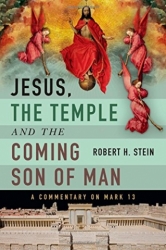Despite the pivotal importance of Mark 13 in discussions of eschatology, Jesus’ famous discourse continues to puzzle us. Is he talking about the events of AD 70? Is he talking about the time of his second coming? Is he talking about both? And how do we sort through the details and decide?
Jesus, the Temple, and the Coming Son of Man, by Robert Stein, is a careful, thorough analysis of this often-perplexing discourse by a respected and experienced New Testament scholar. Tom Schreiner says of this book,
The interpretation of Mark 13 is controversial and sometimes a bit baffling. Robert Stein―with his characteristic clarity, common sense and exegetical skill―unpacks the meaning of the passage for readers. Even those who disagree will profit from Stein’s lucid exegesis and will have to wrestle seriously with the arguments he presents for his reading. All readers will recognize the hand of a veteran and wise interpreter at work. We stand in debt to Stein for an outstanding exposition.
Table of Contents
1. Determining Our Goal
2. Key Issues Involved in Interpreting Mark 13
3. Jesus’ Prediction of the Destruction of the Temple (and Jerusalem)
Mark 13:1-4
4. The Coming Destruction of the Temple (and Jerusalem) and the Sign Preceding It
Mark 13:5-23
5. The Coming of the Son of Man
Mark 13:24-27
6. The Parable of the Fig Tree and the Coming Destruction of the Temple (and Jerusalem)
Mark 13:28-31
7. The Parable of the Watchman and the Exhortation to Be Alert for the Coming of the Son of Man
Mark 13:32-37
8. An Interpretative Translation of Mark 13
Robert H Stein is senior professor of New Testament interpretation at The Southern Baptist Theological Seminary, Louisville, Kentucky. He is the author of An Introduction to the Parables of Jesus, The Method and Message of Jesus’ Teachings, Difficult Passages in the New Testament, Luke (New American Commentary), A Basic Guide to Interpreting the Bible, Studying the Synoptic Gospels: Origin and Interpretation and The Synoptic Problem: An Introduction.
